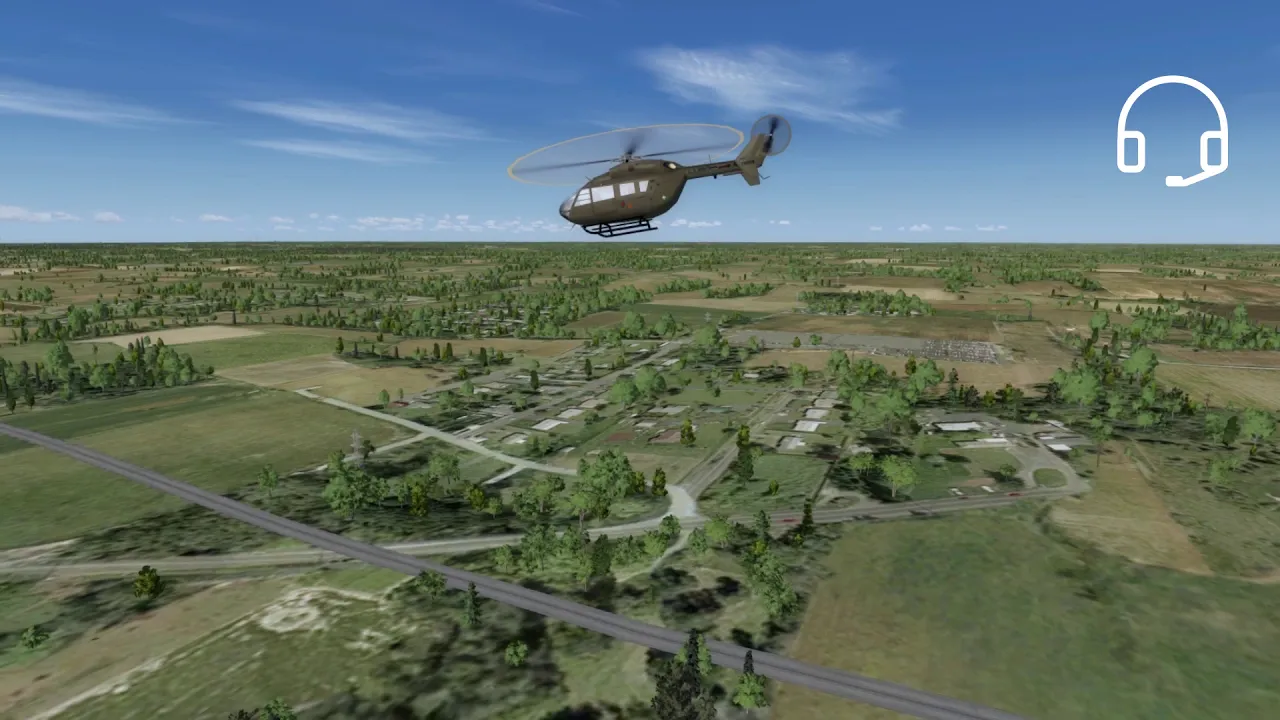Challenges & Solutions
Simple Integration
Assimilate SERA into the customer’s existing solution without significant development or configuration.
The Army’s VR devices use Prepar3D® for the simulation engine and image generator (IG), making SERA a perfect fit. SERA generates entities and displays them in Prepar3D using Distributed Interactive Simulation (DIS) entity state packets, the industry standard. SERA’s built-in Prepar3D interface inherently detects the ownship location, tuned radio frequencies, and transponder settings for easy setup and configuration. The Army can assign press-to-talk capabilities to any joystick button, and trainees listen to ATC calls through their VR headset microphones, which function as audio interfaces.
Small Hardware Footprint
Support more assets with less hardware.
VR-based simulators offer training centers lower costs and a smaller hardware footprint. With off-the-shelf equipment like computers, headsets, and controls, centers can deploy a whole fleet of VR sims for the size and cost of one full-flight simulator.
SERA runs in a virtual environment on a central virtual machine, fitting nicely into compact VR solutions. As a result, multiple VR sims can leverage SERA without any additional hardware. Deploying this lightweight solution saved the Army both an initial hardware investment and ongoing maintenance costs.
Custom Aircraft Behaviors
Populate the synthetic environment with virtual controllers and aircraft entities that follow custom patterns and behaviors, increasing realism.
A primary location for the Army’s initial aviator training, Lucas Stagefield includes six parallel runways and four panels per lane. This complexity made it incredibly unique and challenging to duplicate a realistic ATC environment.
ASTi worked closely with Army aviators to replicate the specialized behaviors of ATC at Lucas Stagefield. Students can request multiple landing types (e.g., run-on landings, hover taxis, sidesteps into assigned parking spaces), all while maintaining a proper distance from SERA’s AI traffic. Meanwhile, SERA’s other virtual entities follow Lucas Stagefield patterns and dynamically react to the synthetic environment.
After training at Lucas Stagefield, students can take a VFR corridor back to Cairns Army Airfield, landing for the day. Students can accomplish all this in a structured or free-play environment that empowers them to learn at their own pace. No instructors required.
Captivating, High-Fidelity Experience
Offload ATC role-playing and provide an alternate way for instructors to provide feedback without breaking immersion.
Previously, a centralized instructor role-played tower ATC, directly speaking to each student. Trainees could only use one headset ear cup, leaving the other free to hear the instructor. Noise pollution from 30 students and 15 instructors all training in the same bay interfered with training, making it difficult to concentrate.
Not anymore. Thanks to ASTi’s SERA and Voisus® products, students can interact with virtual controllers using microphones and headsets. An intercom channel enables instructors equipped with headsets and PTT devices to provide feedback. Now students can finally benefit from the full experience of virtual reality, surrounded by radio transmissions and aural cues from simulated aircraft.
Components Deployed
SERA
Simulated Environment for Realistic ATC
Features
- Speech recognition engine: delivers over 97 percent word accuracy for native English and English as a Second Language (ESL) speakers.
- Scenario generation: build and customize a training exercise that includes a standard flight plan and additional configuration settings.
- Environment generation: automatically generate the appropriate traffic and ATC interactions for any flight plan.
- Flight history transcripts: view past flights, capture performance metrics for every student, review past student responses, and check student scores.
- Traffic plan generation: customize traffic density, call signs, departure and destination airports, and the type of aircraft that appears at an airport.
Voisus Clients
Live, Virtual & Constructive (LVC) voice comms for computers, tablets, & games
Clients connect audio and control interfaces to the Voisus server for digital-signal processing and networked distribution. They also feature simulated, tactical radios that replicate physics-based propagation effects, modulation waveforms, and crypto and frequency-hopping modes.
Features
- Interactive radio faceplates (i.e., skins) running on touchscreen tablets
- A high-value user interface for networked audio interfacing and distribution
- Optional hardware that works with tactical headsets and wireless microphones
